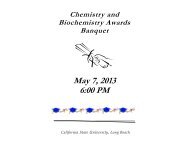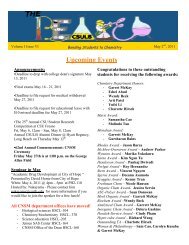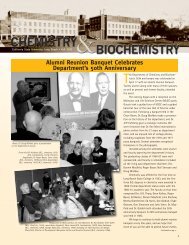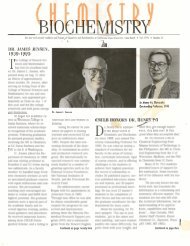2011 - California State University, Long Beach Department of ...
2011 - California State University, Long Beach Department of ...
2011 - California State University, Long Beach Department of ...
You also want an ePaper? Increase the reach of your titles
YUMPU automatically turns print PDFs into web optimized ePapers that Google loves.
A.G. Tharp<br />
6<br />
1927-2 0 11<br />
By Drs. H.N. Po and N.M. Senozan<br />
Dr. A.G. Tharp, who taught in our<br />
department from 1959 to 1987, passed<br />
away in his Lakewood, Calif., home on<br />
June 20. He was 84 years old.<br />
For 28 years, A.G. almost always taught one<br />
<strong>of</strong> the two lecture sections <strong>of</strong> the second half <strong>of</strong><br />
general chemistry,<br />
known originally as<br />
CHEM 1B and later as<br />
CHEM 111B. He also<br />
taught advanced<br />
inorganic courses, served<br />
as graduate advisor and<br />
conducted research on<br />
rare-earth elements,<br />
including ytterbium, samarium and holmium. This<br />
research led to a total <strong>of</strong> 13 publications in leading<br />
chemistry journals. It is not an exaggeration to say<br />
that our department’s tradition <strong>of</strong> excellence in<br />
inorganic chemistry can be traced to Dr. Tharp.<br />
A.G.'s stoic demeanor sometimes masked an<br />
affectionate and generous person who had a deep<br />
appreciation <strong>of</strong> natural beauty. His passion for<br />
orchids reflected this appreciation. On the ro<strong>of</strong> <strong>of</strong><br />
Peterson Hall III, now replaced by the Hall <strong>of</strong><br />
Science, he tended an orchid garden resplendent<br />
in color and form. His extensive knowledge <strong>of</strong><br />
orchids landed him a position as an orchid judge<br />
in the Southern <strong>California</strong> section <strong>of</strong> the American<br />
Orchid Society, and later, recognition as a<br />
Distinguished Emeritus Orchid Judge.<br />
After retiring in 1987, A.G. went to the<br />
Philippines and ventured into the orchid growing<br />
business with a Filipino grower. The tropical<br />
climate and the cheap labor helped the business<br />
thrive for some 10 years. Then, salt water seeped<br />
unexpectedly into the artesian wells, and the<br />
business went downhill. Dr. Tharp returned to<br />
<strong>California</strong>—not a bitter man but happy that he<br />
had 10 great years to do what he loved.<br />
Dr. Tharp's deliberate, slow cadence in<br />
speech and motion hid another surprising skill<br />
from a casual observer. He was an avid flyer, who<br />
<strong>of</strong>ten treated his students and colleagues to the<br />
unforgettable thrills <strong>of</strong> flying in his small plane.<br />
At times, A.G. could be quite quirky, and his<br />
charm, in part, rested on his idiosyncrasies. One<br />
that we remember well was his revulsion to any<br />
mention <strong>of</strong> the Henderson-Hasselbalch equation<br />
or any use <strong>of</strong> this equation by a student on an<br />
exam. He apparently could not accept that a<br />
simple rearrangement <strong>of</strong> the equilibrium constant<br />
expression would immortalize these two names.<br />
Dr. Tharp is survived by a sister and her<br />
family in Kentucky.<br />
<strong>2011</strong> Distinguished Lecturer:<br />
MIT’s Stephen J. Lippard<br />
Stephen J. Lippard, a renowned bioinorganic<br />
chemist, visited our department on March<br />
23 as this year’s Allergan Distinguished<br />
Lecturer. Dr. Lippard is the Arthur Amos Noyes<br />
Pr<strong>of</strong>essor <strong>of</strong> Chemistry at the Massachusetts<br />
Institute <strong>of</strong> Technology. His research focus is at<br />
the interface <strong>of</strong> inorganic chemistry and biology<br />
and combines theoretical and synthetic<br />
organometallic chemistry, structural and<br />
mechanistic biochemistry, and studies <strong>of</strong> cultured<br />
cells and living organisms.<br />
Dr. Lippard presented a morning lecture<br />
entitled “Understanding and Improving Platinum<br />
Anticancer Drugs.” Cisplatin (cis-diammin -<br />
edi chlo ro platinum(II)) was serendipitously<br />
discovered to have anticancer activity in the<br />
1960s and has been used as an approved anticancer<br />
drug since 1978, but our understanding<br />
<strong>of</strong> its mechanism <strong>of</strong> action is the result <strong>of</strong> subsequent<br />
studies in Dr. Lippard’s lab. Dr. Lippard<br />
presented chemical and structural studies <strong>of</strong><br />
adducts between a variety <strong>of</strong> platinum agents<br />
and DNA and on chromatin containing modified<br />
DNA. He showed evidence that DNA modified<br />
with platinum compounds causes the<br />
enzyme RNA Polymerase II to stall during transcription<br />
and thus inhibits the produc tion <strong>of</strong><br />
messenger RNA in tumor cells. He discussed<br />
his lab’s work in designing and synthesizing<br />
new versions <strong>of</strong> platinum compounds with<br />
optimized drug properties, including platinum<br />
drugs attached to nanomolecular constructs.<br />
Dr. Lippard’s afternoon lecture was entitled<br />
“Probing Roles <strong>of</strong> Mobile Zinc and Nitric<br />
Oxide Signaling in Biology.” He discussed his<br />
lab’s development <strong>of</strong> new fluorescent sensors<br />
By Jeff Cohlberg<br />
capable <strong>of</strong> sensitively detecting and accurately<br />
quantifying zinc and nitric oxide in cells. Studies<br />
using these sensors have revealed new roles<br />
for zinc in the nervous system and may also<br />
lead to a new approach for early detection <strong>of</strong><br />
prostate cancer. New probes for nitric oxide are<br />
being used to study changes in NO concentration<br />
during a wide variety <strong>of</strong> biological processes.<br />
Dr. Lippard’s lab also has a major focus on<br />
studying the mechanism <strong>of</strong> metalloenzymes,<br />
including diiron hydroxylase.<br />
Dr. Lippard was a pr<strong>of</strong>essor at Columbia<br />
<strong>University</strong> from 1966-83, before he moved to MIT.<br />
He is the author <strong>of</strong> over 750 publications and coauthor<br />
<strong>of</strong> the text Principles <strong>of</strong> Bioinor ganic<br />
Chemistry with Jeremy Berg. He is a member <strong>of</strong><br />
the National Academy <strong>of</strong> Sciences, the National<br />
Institute <strong>of</strong> Medicine and the American Academy<br />
<strong>of</strong> Arts and Sciences. He has received many<br />
awards and honorary degrees, most notably the<br />
2006 National Medal <strong>of</strong> Science, the nation’s<br />
highest science honor. Also, he has received the<br />
Linus Pauling, Theodore W. Richards and William<br />
H. Nichols Medals. The American Chemical<br />
Society has recognized him with the Ronald<br />
Breslow and Alfred Bader Awards, the ACS Award<br />
for Inorganic Chemistry and the ACS Award for<br />
Distinguished Service in Inorganic Chemistry.<br />
The talks were well attended by students and<br />
faculty. We are grateful to Allergan for their<br />
continued support <strong>of</strong> the Distinguished Lecturer<br />
program, making it possible for our students and<br />
faculty to meet and interact with truly outstanding<br />
scientists using chemistry to tackle problems at<br />
the frontiers <strong>of</strong> knowledge.


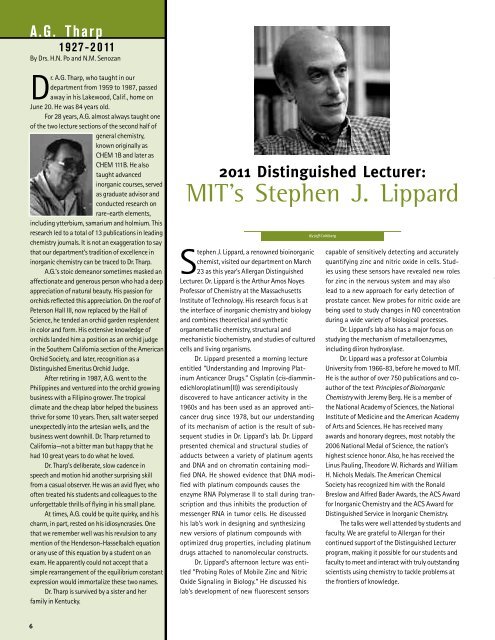
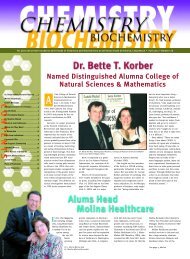
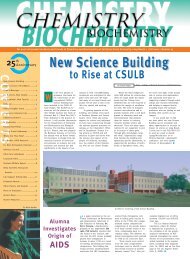
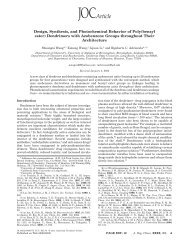
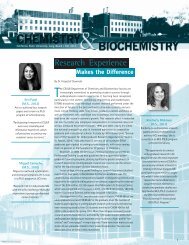
![Volume 4, Issue 3 [November 2012 pdf] - California State University ...](https://img.yumpu.com/34605825/1/190x245/volume-4-issue-3-november-2012-pdf-california-state-university-.jpg?quality=85)
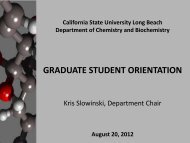
![Volume 5, Issue 2 [April 2013 pdf] - California State University, Long ...](https://img.yumpu.com/33273195/1/190x245/volume-5-issue-2-april-2013-pdf-california-state-university-long-.jpg?quality=85)
